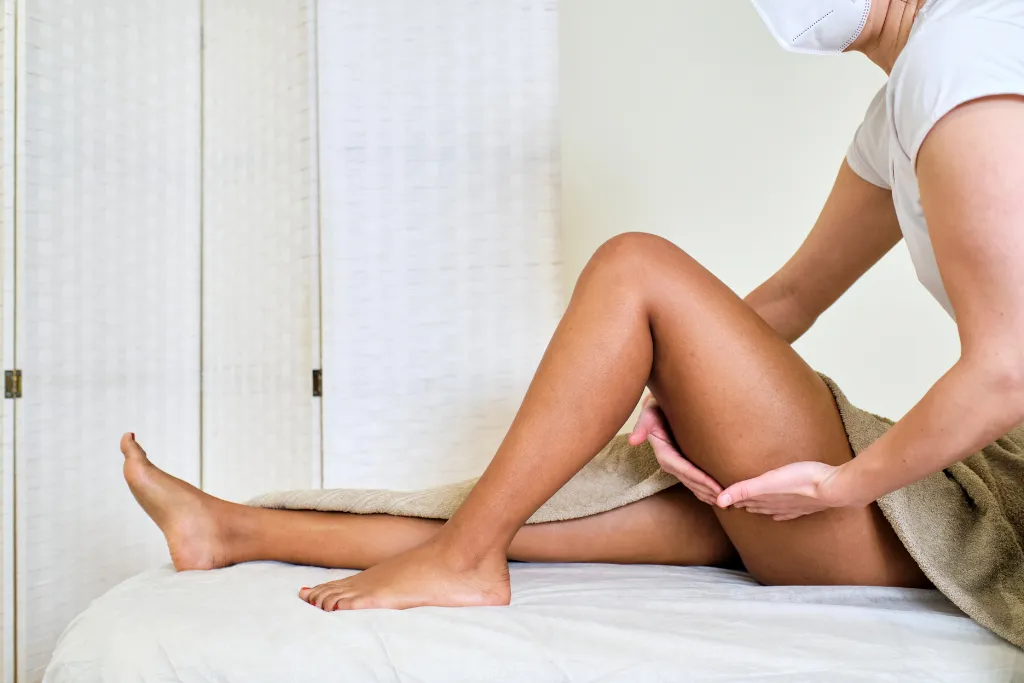Lymphatic system: An important part of the body’s immune system to drain muscle tissues of excess fluid, toxins, and products. It works in concert with the circulatory system, but unlike blood, which gets pumped around the body by the heart, lymph fluid travels through the body through a combination of muscle movement, deep breathing, and manual stimulation.
When we don’t move enough, or when the lymphatic system is compromised from cancer surgery, breast cancer treatment, and other health conditions, fluid builds up and swells, especially in our legs. This condition, called lymphedema, can lead to pain, heaviness, and a greater risk of infection.
The good news is that there are multiple effective ways to help move lymph fluid, reduce swelling, and improve overall lymph drainage in the legs. Let’s explore them in detail.
Why Is Lymphatic Drainage Important?
As an auxiliary second, the lymphatic system has access to the immune anatomy, and it assimilates excess of the after (or toxins or after artifacts of their metabolism) of the tessellation.
It runs parallel to the circulatory system, but unlike blood, which is circulated by the heart, lymph fluid flows throughout the body through muscle movement, deep breathing , and manual stimulation.
- Swelling in the legs, ankles, or feet
- Pain or tightness in the affected limb
- Swelling and decreased mobility
- Stagnant fluid leads to recurrent infections
- Skin that gets thickened or hard over time
Wellness Programs Moving lymph can be as easy as using lymphatic drainage techniques to reduce fluid buildup in the body, supporting lymph movement in the body, and optimizing health through lymphatic drainage.
How to Improve Lymphatic Drainage in Legs
1. Movement and Exercise
Stimulating the lymphatic system’s movement of fluid depends mostly on regular physical exercise. An exercise program that supports lymphatic circulation increases movement of lymph since lymphatic circulation depends on muscular contractions.
Effective Lymphatic Drainage Exercises
- Ankle Circles: To increase circulation, turn your ankles in both directions.
- Heel Raises: Stand with feet flat and lift onto your toes, then lower slowly.
- March in Place: Stand, engage your core, and raise your knees.
- Flutter Kicks: Lie on your back and alternate in fluttering motion, lifting your legs.
- Water Exercise: Exercising in water helps move lymph and provides natural compression to reduce swelling.
Tip: It’s best to combine exercise program routines with deep breathing techniques, as this encourages lymphatic fluid movement.
2. Compression Garments
Compressions with a variance of controlled pressure will help reduce swelling and provide lymph vessels in action. Commercially available foams, taping, post-operative bras, and compression garments are often recommended for women recovering from surgical treatment for cancer, breast cancer surgery, and/or those diagnosed with lymphedema.
Types of Compression Garments for Lymphatic Drainage:
| Type | Purpose |
| Compression Stockings | Improve circulation and prevent fluid buildup in the legs. |
| Compression Tights | Offer full-leg support to reduce swelling and discomfort. |
| Compression Bandages | Often used under medical supervision to help move fluid efficiently. |
Tip: Consult a healthcare provider or lymphedema therapist to ensure a proper fit, as poorly fitted compression garments may restrict circulation.
3. Manual Lymphatic Drainage (MLD) and Massage
Lymphatic drainage massage is a gentle technique designed to stimulate lymphatic vessels and nodes and help move lymph fluid effectively. This technique, also called manual lymphatic drainage, is often performed by a lymphedema therapist, but you can also practice self-massage techniques at home.
How to Perform Self-Manual Lymphatic Drainage:
- Start at the Neck: Gently rub the muscle around your collarbone, because this is where fluid is drained into the bloodstream.
- Massage the Groin and Thighs: Gently stroke the lymph fluid upwards.
- Work Down the Legs: Use massage techniques such as light circular motions and tapping to move fluid out of swollen areas.
- Finish at the Ankles and Feet: Using slow, rhythmic strokes, guide excess lymph fluid toward the trunk of the body.
Tip: Unlike traditional massage, lymphatic drainage massage requires light pressure, as deep tissue manipulation can damage delicate lymph vessels.
4. Elevation to Reduce swelling
Elevation of the legs above heart level can assist with swelling and discretionary lymphatic fluid movement for 20–30 minutes at a time. Elevation promotes, with the aid of gravity, fluid flow to the natural central drainage sites of lymphatic fluid in the groin and abdomen.
Best Practices for Leg Elevation:
- Stay lying down and prop your legs up on pillows.
- Keep your legs elevated in a recliner or adjustable bed.
- Add some deep breathing exercises while elevating.
Tip: Prop up your legs a few times each day, particularly if you notice pooling after being on them for a while.
5. Hydration and a Healthy Diet
Staying hydrated and getting the right amount of food will help your lymph system perform at its best and discourage bloating.
Dietary Suggestions to Help Keep Your Lymphatic System Healthy:
- Can drink plenty of water to help lymph fluid to move quickly.
- Limit salt intake since sodium can lead to water retention.
- Consume foods that are high in fiber, which helps digestion and release toxins.
- Turmeric (add it to hot milk)—because it’s anti-inflammatory.
- Include omega-3 fatty acids (found in fish and nuts) to reduce inflammation.
Tip: Lack of water can hinder lymphatic drain and cause sluggish circulation.

6. Avoiding Risk Factors and Seeking Professional Help
Certain conditions, including cancer surgery, breast cancer, and lymphedema diagnosis, increase the risk of developing lymphatic issues. If you experience persistent signs of lymphedema, such as fluid retention, consult a healthcare provider or lymphedema therapist for diagnosis and treatment.
When to See a Doctor:
- Chronic swelling that doesn’t improve with home care.
- Frequent infections in the affected limb.
- Tightness or heaviness in the legs.
- Skin hardening or discoloration.
A care team specializing in lymphedema symptoms may include physical therapists, lymphedema therapists, and medical specialists to help create a treatment plan that includes manual lymph drainage, an exercise program, and compression therapy.
Final Thoughts
The techniques for lymphatic drainage on the legs include a combination of physical exercise, compression treatment, lymphatic massage, and lifestyle changes.
If you are recovering from breast cancer (or have undergone other surgeries), these techniques can really help, too, whether you are managing lymphedema symptoms or just seeking to improve your circulatory system’s ability. If you’re at risk of developing lymphedema, check in regularly with a healthcare provider or lymphedema specialist to develop a personalized care plan.
Lymphatic drainage massage can help, but the best way to support your lymph system and overall health is through a holistic approach that includes movement, hydration, and proper nutrition.

